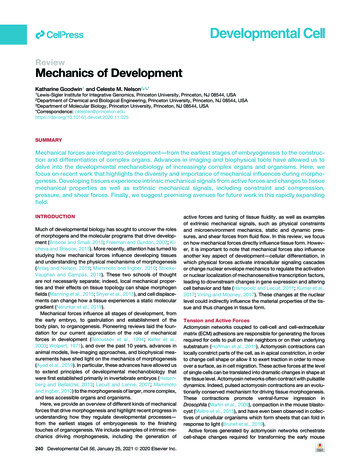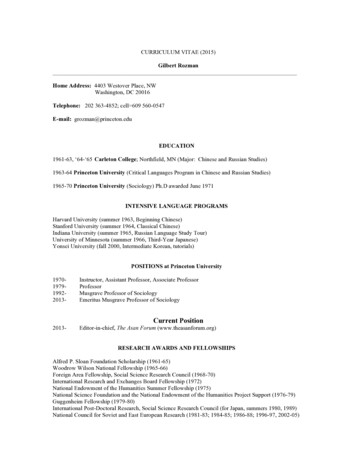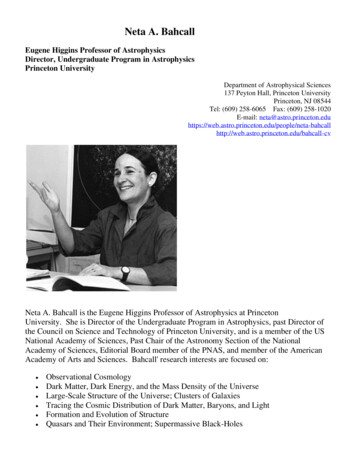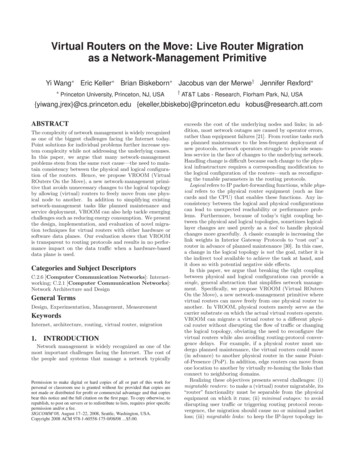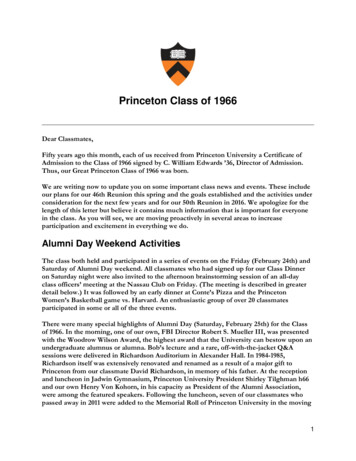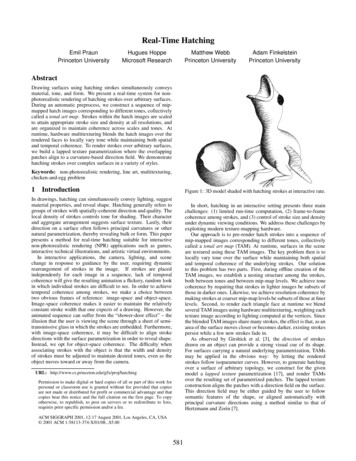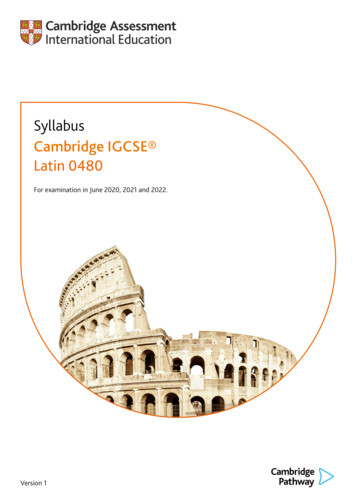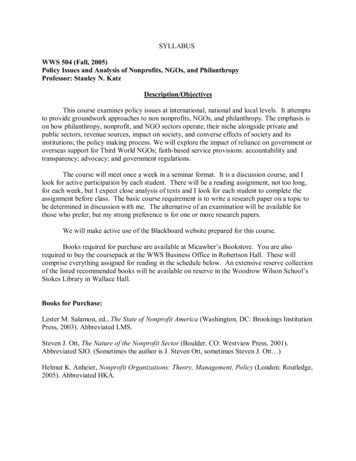
Transcription
SYLLABUSWWS 504 (Fall, 2005)Policy Issues and Analysis of Nonprofits, NGOs, and PhilanthropyProfessor: Stanley N. KatzDescription/ObjectivesThis course examines policy issues at international, national and local levels. It attemptsto provide groundwork approaches to non nonprofits, NGOs, and philanthropy. The emphasis ison how philanthropy, nonprofit, and NGO sectors operate, their niche alongside private andpublic sectors, revenue sources, impact on society, and converse effects of society and itsinstitutions; the policy making process. We will explore the impact of reliance on government oroverseas support for Third World NGOs; faith based service provisions: accountability andtransparency; advocacy; and government regulations.The course will meet once a week in a seminar format. It is a discussion course, and Ilook for active participation by each student. There will be a reading assignment, not too long,for each week, but I expect close analysis of texts and I look for each student to complete theassignment before class. The basic course requirement is to write a research paper on a topic tobe determined in discussion with me. The alternative of an examination will be available forthose who prefer, but my strong preference is for one or more research papers.We will make active use of the Blackboard website prepared for this course.Books required for purchase are available at Micawber’s Bookstore. You are alsorequired to buy the coursepack at the WWS Business Office in Robertson Hall. These willcomprise everything assigned for reading in the schedule below. An extensive reserve collectionof the listed recommended books will be available on reserve in the Woodrow Wilson School’sStokes Library in Wallace Hall.Books for Purchase:Lester M. Salamon, ed., The State of Nonprofit America (Washington, DC: Brookings InstitutionPress, 2003). Abbreviated LMS.Steven J. Ott, The Nature of the Nonprofit Sector (Boulder, CO: Westview Press, 2001).Abbreviated SJO. (Sometimes the author is J. Steven Ott, sometimes Steven J. Ott )Helmut K. Anheier, Nonprofit Organizations: Theory, Management, Policy (London: Routledge,2005). Abbreviated HKA.
Websites relevant to Nonprofits, NGOs and Philanthropy:General sites: Idealist.org: www.idealist.org (clearing house for nonprofit ideas and news) NonprofitHub.com: www.nonprofithub.com (very large list of links, broken down by category;some broken, some frivolous) Urban Institute: www.urban.org (general social and economic policy research institute, withsection devoted to nonprofits and philanthropy) Guidestar: www.guidestar.org (basic data about nonprofits organization includingorganization’s tax Form 990 images; free registration required) Independent Sector: www.independentsector.org (broad based coalition dedicated toimproving America’s third sector) Harvest Today: http://www.harvesttoday.org (nonprofit and philanthropy news andinformation service)On Philanthropy: EPhilanthropyFoundation.org: www.ephilanthropy.org (organization dedicated to promotingonline philanthropy; includes ezine) Ashoka: www.ashoka.org (organization supporting social entrepreneurship, with sectiondedicated to nonprofits and philanthropy) Philanthropy News Digest: http://fdncenter.org/pnd (Foundation Center’s online newspaper) American Association of Fundraising Counsel: http://www.aafrc.org (Organization dedicatedto professionalizing and ensuring ethical behavior amongst philanthropies) The Philanthropic Initiative: http://www.tpi.org (TPI offers strategic services tophilanthropists) American Institute of Philanthropy: http://www.charitywatch.org (general purposephilanthropy website, including ratings of organizations) Nonprofit Management Education Center: http://www.uwex.edu/li/learner/sites.htm (large listof links to a variety of third sector related sites)On foundations: Foundation Center: www.fdncenter.org (database on foundations, for both students andpractitioners of philanthropy) Foundation Center’s international philanthropy page:http://fdncenter.org/research/npr links/npr08 int.html Council on Foundations: www.cof.org (membership organization of foundations providinginformation, expertise and advice to foundations and general public) Minnesota Council on Foundations: http://www.mcf.org (includes a variety of non Minnesotalinks, especially under “Links of Interest”)On NGOs, US and international: Duke University Non governmental Organizations Research Guide:
http://docs.lib.duke.edu/igo/guides/ngo (includes very comprehensive list of NGOs, includinginternational ones, with weblinks) Boardsource: http://www.boardsource.org (dedicated to NGO development, especially ofboards and their members) Global Policy Forum: http://www.globalpolicy.org/ngos/index.htm (GPF monitors UN policymaking; this page relates to the UN and NGOs)September 21 Session 1: Introduction and course overview.Required reading: Pablo Eisenberg, “Introduction: The Key Issues Facing Nonprofit Groups in the Twenty FirstCentury,” in his Challenges for Nonprofits and Philanthropy: The Courage to Change (Hanover,NH: University Press of New England, 2005), ed. Stacy Palmer. Pp. 1 22. Peter Frumkin, “The Idea of a Nonprofit and Voluntary Sector,” in his On Being Nonprofit: AConceptual and Policy Primer (Cambridge, MA: Harvard University Press, 2002). Pp. 1 28.1. The United StatesSeptember 28 Session 2: The third sector in the United StatesRequired reading: Virginia Hodgkinson and Murray Weitzman, “Overview: The State of the Nonprofit Sector,” inSJO. 14 pages Peter Dobkin Hall, “Inventing the Nonprofit Sector: 1950 1990,” in SJO. 14 pages Lester M. Salamon, “The Resilient Sector: The State of Nonprofit America,” in LMS.63 pages Michael O’Neill, “Nonprofit Nation,” in his Nonprofit Nation: A New Look at the ThirdAmerica (San Francisco, CA: Jossey Bass, 2002). Pp. 1 34.Recommended reading:David C. Hammack, “Introduction: Growth, Transformation and Quiet Revolution in theNonprofit Sector over Two Centuries,” Nonprofit and Voluntary Sector Quarterly, 2001, 30(1),pp. 157 173.Peter Dobkin Hall, “Historical Perspectives on Nonprofit Organizations in the United States,” inRobert Herman, ed., The Jossey Bass Handbook of Nonprofit Leadership and Management (SanFrancisco, CA: Jossey Bass, 2004).
Linda Lampkin and Elizabeth Boris, “Nonprofit Organization Data: What We Have and WhatWe Need,” American Behavioral Scientist, 2002, 45(11), pp. 1675 1715.David C. Hammack, ed., Making the Nonprofit Sector in the United States: A Reader(Bloomington, IN: Indiana University Press, 2000).Kristen Renwick Monroe, “A Fat Lady in a Corset: Altruism and Social Theory,” AmericanJournal of Political Science, 1994, 38(4), pp. 861 893.Lester M. Salamon, “In Search of the Nonprofit Sector I: The Question of Definitions,”Voluntas, 1992, 3(2), pp. 125 151.Jon Van Til, “Defining Philanthropy,” in Jon Van Til and Associates, eds., Critical Issues inAmerican Philanthropy: Strengthening Theory and Practice (San Francisco, CA: Jossey Bass,1990).Lawrence J. Friedman and Mark D. McGarvie, eds., Charity, Philanthropy and Civility inAmerican History (Cambridge: CUP, 2003).October 5 Session 3: Theories of the third sector; the role and impact of the third sectorRequired reading: William A. Diaz, “For Whom and For What? The Contributions of the Nonprofit Sector,” inLMS. 19 pages David Horton Smith, “The Impact of the Voluntary Sector on Society,” in SJO. 8 pages Michael O’ Neill, “Theories,” in his Nonprofit Nation: A New Look at the Third America (SanFrancisco, CA: Jossey Bass, 2002). Pp. 35 52. Helmut K. Anheier, “Theoretical Approaches” and “Resourcing the Nonprofit Sector” in HKA.55 pages Charles T. Clotfelter, “The Distributional Consequences of Nonprofit Activities,” in Charles T.Clotfelter, ed., Who Benefits From the Nonprofit Sector? (Chicago, IL: University of ChicagoPress, 1992). Pp. 1 23.Lester M. Salamon, “The Nonprofit Sector at the Local Level,” in his Partners in Public Service:Government Nonprofit Relations in the Modern Welfare State (Baltimore, MD: Johns HopkinsUniversity Press, 1995). Pp. 59 66.Recommended reading:Helmut K. Anheier and Avner Ben Ner, eds., The Study of the Nonprofit Enterprise: Theoriesand Approaches (New York, NY: Kluwer, 2003).
Kirsten Gronbjerg, Understanding Nonprofit Funding: Managing Revenues in Social Serviceand Community Development Organizations (Sanfrancisco, CA: Jossey Bass, 1993).Brian E. Dollery and Joe L. Wallis, “Voluntary Organizations as a Response to Market andGovernment Failure” & “Supply side Theories of Nonprofit Organizations,” in their ThePolitical Economy of the Voluntary Sector: A Reappraisal of the Comparative InstitutionalAdvantage of Voluntary Organizations (Northampton, MA: Edward Elgar, 2003).Herrington J. Bryce, “The Policy Significance of Nonprofit Organizations: Beyond the Limits ofFailure,” in his Players in the Public Policy Process: Nonprofits as Social Capital and Agents(New York, NY: Palgrave Macmillan, 2005).Patrice Flynn and Virginia A. Hodgkinson, eds., Measuring the Impact of the Nonprofit Sector(New York, NY: Kluwer, 2002).Alan Abramson and J. Spann, eds., Foundations: Exploring their Unique Roles and Impacts inSociety (Washington DC: Urban Institute Press, 1999).Charles T. Clotfelter, Who Benefits From the Nonprofit Sector? (Chicago, IL: University ofChicago Press, 1992).October 12 Session 4: FoundationsRequired reading: Helmut K. Anheier, “Foundations,” in HKA. 27 pages Barry D. Karl and Stanley N. Katz, “Foundations and Ruling Class Elites,” Daedalus: Journalof the American Academy of Arts and Sciences, 116/1, Winter 1987, pp. 1 40. Joan Roelofs, “Introduction,” “What are Foundations?’ & “Ideology and Information,” in herFoundations and Public Policy: The Mask of Pluralism (Albany, NY: SUNY Press, 2003).Pp. 1 63. J. Craig Jenkins, “Channeling Social Protest: Foundation Patronage of Social Movements,” inWalter W. Powell and Elisabeth S. Clemens, eds., Private Action and the Public Good (NewHaven: Yale UP, 1999). Pp. 206 216. Mark Dowie, “Introduction,” “Democracy,” and “Epilogue,” in his American Foundations: AnInvestigative History (Cambridge, MA: MIT Press, 2001). Pp. xix xl, 247 270.Recommended reading:Alan Abramson and J. Spann, eds., Foundations: Exploring their Unique Roles and Impacts inSociety (Washington DC: Urban Institute Press, 1999)
Mark Dowie, American Foundations: An Investigative History (Cambridge, MA: MIT Press,2001).Waldemar Nielsen, The Big Foundations (New York, NY: Columbia University Press, 1972).Robert Arnove, ed., Philanthropy and Cultural Imperialism: The Foundations at Home andAbroad (Boston, MA: G.K. Hall, 1980).Ellen Condliffe Lagemann, ed., Philanthropic Foundations: New Scholarship, New Possibilities(Bloomington, IN: Indiana University Press, 1999)H. Peter Karoff, ed., Just Money: A Critique of Contemporary American Philanthropy (Boston,MA: The Philanthropic Initiative, 2004)October 19 Session 5: The third sector and governmentRequired reading: Helmut K. Anheier, “State nonprofit relations,” in HKA. 19 pages Dennis R. Young, “Complementary, Supplementary or Adversarial? A Theoretical andHistorical Evaluation of Nonprofit Government Relations in the United States,” in Elizabeth T.Boris and C. Eugene Steuerle, eds., Nonprofits and Government: Collaboration and Conflict(Washington, DC: Urban Institute Press, 1999). Pp. 31 67. Jon Van Til, “The Third Sector as a Political Force,” in his Growing Civil Society: FromNonprofit Sector to Third Space (Bloomington, IN: Indiana University Press, 2000). Pp. 31 42. Steven J. Ott, “Perspectives on Organizational Governance: Some Effects on Government Nonprofit Relations,” in SJO. 10 pages Judith Saidel, “Resource Interdependence: The Relationship between State Agencies andNonprofit Organizations,” in SJO. 10 pages Kirsten Gronbjerg and Lester M. Salamon, “Devolution, Marketization and the ChangingShape of Government Nonprofit Relations,” in LMS. 23 pages Barry D. Karl and A.W. Karl, “Foundations and the Government: A Tale of Conflict andConsensus,” in Charles T. Clotfelter and Thomas Ehrlich, eds., Philanthropy and the NonprofitSector in a Changing America (Bloomington, IN: Indiana University Press, 1999). Pp. 52 72.Recommended reading:Elizabeth T. Boris and C. Eugene Steuerle, eds., Nonprofits and Government: Collaboration andConflict (Washington, DC: Urban Institute Press, 1999)
Richard Magat, ed., Philanthropic Giving: Studies in Varieties and Goals (New York, NY: OUP,1989), Part III.Joan Roelofs, “Reforming Government,” in her Foundations and Public Policy: The Mask ofPluralism (Albany, NY: SUNY Press, 2003).Lester M. Salamon, Partners in Public Service: Government Nonprofit Relations in the ModernWelfare State (Baltimore, MD: Johns Hopkins university Press, 1995)A. Najam, “The Four C’s of Third Sector Government Relations: Cooperation, Confrontation,Complementarity and Co optation,” Nonprofit Management and Leadership, 2000, 10(4), pp.375 397.Jennifer Wolch, “State, Subject, Space: Silences in Institutionalist Theories of Nonprofit Government Relations,” in Helmut K. Anheier and Avner Ben Ner, eds., The Study of theNonprofit Enterprise: Theories and Approaches (New York, NY: Kluwer, 2003).October 26 Session 6: The third sector and the marketRequired reading: Jon Van Til, “When the Business of Nonprofits is Increasingly Business,” in his Growing CivilSociety: From Nonprofit Sector to Third Space (Bloomington, IN: Indiana University Press,2000). Pp. 113 26. James T. Bennett and Thomas J. Dilorenzo, “Preface,” “Unfair Competition: Issues andImplications” & “The Dimensions of the Commercial nonprofit Sector” in their UnfairCompetition: The Profits of Nonprofits (Lanham: Hamilton Press, 1989). Pp. 1 43. Claire Gaudiani, “Introduction,” “Democracy, Capitalism and Generosity: The FragileBalance” & “Generosity and the Future of Democratic Capitalism,” in her The Greater Good:How Philanthropy Drives the American Economy and Can Save Capitalism (New York, NY:Times Books, 2003). Pp. 1 30, 134 157. Burton A. Weisbrod, The Future of the Nonprofit Sector: Its Entwining with Private Enterpriseand Government,” in SJO. 10 pages Dennis R. Young and Lester M. Salamon, “Commercialism, Social Ventures and For ProfitCompetition,” in LMS. 22 pages Michael E. Porter and Mark R. Kramer, “Philanthropy’s New Agenda: Creating Value,”Harvard Business Review, November December 1999, pp. 121 130. Christine W. Letts, William Ryan and Allen Grossman, “Virtuous Capital: What Foundationscan Learn from Venture Capitalists,” Harvard Business Review, March April 1997, pp. 36 44.
Recommended reading:David Bornstein, How to Change the World: Social Entrepreneurs and the Power of New Ideas(Oxford: OUP, 2004).Christopher Gunn, Third Sector Development: Making up for the Market (Ithaca, NY: CornellUniversity Press, 2004).J. Gregory Dees, Jed Emerson, and Peter Economy, Enterprising Nonprofits: A Toolkit for SocialEntrepreneurs (New York, NY: John Wiley and Sons, 2001).November 2 – Fall BreakNovember 9 Session 7: The third sector and religion; faith based initiativesRequired reading: Robert Wuthnow, “The Religious Dimensions of Giving and Volunteering,” in Patrice Flynnand Virginia A. Hodgkinson, eds., Measuring the Impact of the Nonprofit Sector (New York,NY: Kluwer, 2002). Pp. 231 245. Mark Chaves, “Religious Congregations,” in LMS. 23 pages Peter Dobkin Hall, “‘A Bridge Founded Upon Justice and Built of Human Hearts’: Reflectionson Religion and Philanthropy,” in his Inventing the Nonprofit Sector and Other Essays onPhilanthropy, Voluntarism and Nonprofit Organizations (Baltimore: Johns Hopkins UniversityPress, 1992) Pp. 115 133. James R. Wood and James G. Hougland, “The Role of Religion in Philanthropy,” in Jon VanTil and Associates, eds., Critical Issues in American Philanthropy: Strengthening Theory andPractice (San Francisco, CA: Jossey Bass, 1990). Pp. 99 132.Recommended reading:John DiIulio, “The Lord’s Work: The Church and Civil Society,” in E.J. Dionne Jr. ed.,Community Works: The Revival of Civil Society in America (Washington DC: The BrookingsInstitution, 1998)Robert Wuthnow, “Clash of Values: The State, Religion, and the Arts,” in Elizabeth T. Boris andC. Eugene Steuerle, eds., Nonprofits and Government: Collaboration and Conflict (Washington,DC: Urban Institute Press, 1999)E.J. Dionne, Jr., and M.H. Chen, Sacred Places, Civil Purposes: Should Government HelpFaith Based Charity? (Washington DC: The Brookings Institution, 2001)
Peter Frumkin, “Values and Faith” in his On Being Nonprofit: A Conceptual and Policy Primer(Cambridge, MA: Harvard University Press, 2002)Jo Renee Formicola, Mary C. Segers, and Paul Weber, Faith Based Initiatives and the BushAdministration: The Good, the Bad, and the Ugly (Lanham, MD: Rowman and LittlefieldPublishers, Inc, 2003)Amy E. Black, Douglas L. Koopman, and David K. Ryden, Of Little Faith: The Politics ofGeorge W. Bush’s Faith Based Initiatives (Washington, DC: Georgetown University Press,2004)November 16 Session 8: Accountability, transparency, advocacyRequired reading: Helmut K. Anheier, “Stakeholders, Governance and Accountability,” in HKA. 16 pages Jeffrey M. Berry and David F. Arons, “The Age of Nonprofits” & “The Rules are NeverNeutral,” in their A Voice for Nonprofits (Washington, DC: Brookings Institution Press, 2003).Pp. 1 23, 146 166 Pablo Eisenberg, “Grant Makers’ Aversion to Advocacy Ignores the Lessons of History,” in hisChallenges for Nonprofits and Philanthropy: The Courage to Change (Hanover, NH: UniversityPress of New England, 2005), ed. Stacy Palmer. Pp. 140 143. Pablo Eisenberg, “The Buck Stops with the Board of Directors,” “Corporate Values CouldPoison Nonprofits,” “Accountability and the Weinberg Foundation,” “Press Coverage Sends aMessage to Nonprofits: Clean up Your Act,” “How to Help the IRS Improve Charity Oversight”& “Why Charities Think They Can Regulate Themselves,” all in his Challenges for Nonprofitsand Philanthropy: The Courage to Change (Hanover, NH: University Press of New England,2005), ed. Stacy Palmer. Pp. 153 159, 171 178, 182 184 & 187 189 Theda Skocpol, “From Membership to Advocacy,” in Robert Putnam, ed., Democracies inFlux: The Evolution of Social Capital in Contemporary Society (Oxford: Oxford UniversityPress, 2002). Pp. 103 136. Evelyn Brody, “Accountability, Effectiveness, and Public Perceptions,” in LMS. 26 pagesRecommended reading:S. Kumar, “Accountability: What Is It and Why Do We Need It?” in S. Osborne, ed., Managingin the Voluntary Sector (London: Thomson, 1996)
Elizabeth J. Reid, “Nonprofit Advocacy and Participation,” in Elizabeth T. Boris and C. EugeneSteuerle, eds., Nonprofits and Government: Collaboration and Conflict (Washington, DC: UrbanInstitute Press, 1999).Kevin P. Kearns, “Accountability Concepts and Controversies,” in J. Steven Ott, ed.,Understanding Nonprofit Organizations: Governance, Leadership and Management (Boulder,Co: Westview Press, 2001).Thomas H. Jeavons, “Ethics in Nonprofit Management: Creating a Culture of Integrity,” in J.Steven Ott, ed., Understanding Nonprofit Organizations: Governance, Leadership andManagement (Boulder, Co: Westview Press, 2001).2. Beyond the United StatesNovember 23 Session 9: IntroductionRequired reading: Helmut K. Anheier, “International Issues and Globalization,” in HKA. 30 pages Lester M. Salamon, “Government Nonprofit Relations in International Perspective,” inElizabeth T. Boris and C. Eugene Steuerle, eds., Nonprofits and Government: Collaboration andConflict (Washington, DC: Urban Institute Press, 1999). Pp. 329 367. Sheppard Foreman and Abby Stoddard, “International Assistance,” in LMS. 34 pages “Introduction” and Andres A. Thompson and Leilah Landim, “Civil Society and Philanthropyin Latin America: From Religious Charity to the Search for Citizenship” in Warren F. Ilchman,Stanley N. Katz and Edward L. Queen, II, eds., Philanthropy in the World’s Traditions,(Bloomington, IN: Indiana University Press, 1998). Pp. ix xv & 355 370.Recommended Reading:David Bornstein, How to Change the World: Social Entrepreneurs and the Power of New Ideas(Oxford: OUP, 2004).J. Boli and G.M Thomas, “World Culture in the World Polity: A Century of International Non governmental Organizations,” American Sociological Review, 1997, 62(2), pp. 171 190.S. Charnovitz, “Two Centuries of Participation: NGOs and International Governance,” MichiganJournal of International Law, 1997, 18, pp. 183 286.
Session 9: Globalization and the third sector; international NGOs; the US third sector on theworld stageRequired reading: John D. Clark, Worlds Apart: Civil Society and the Battle for Ethical Globalization (London:Earthscan, 2003). Pp. 3 17, 91 108. L. David Brown and Mark H. Moore, “Accountability, Strategy and InternationalNongovernmental Organizations,” Nonprofit and Voluntary Sector Quarterly, 2001, 30(3), pp.569 587. Michael O’Neill, “International,” in his Nonprofit Nation: A New Look at the Third America(San Francisco, CA: Jossey Bass, 2002). Pp. 169 179. Adele Simmons, “Global Giving,” in H. Peter Karoff, ed., Just Money: A Critique ofContemporary American Philanthropy (Boston, MA: The Philanthropic Initiative, 2004). Pp.203 233.Recommended reading:Marina Ottaway and Thomas Carothers, eds., Funding Virtue: Civil Society Aid and DemocracyPromotion (Washington, DC: Carnegie Endowment for International Peace, 2000).Loren Renz, “International Grant Making by US Foundations: Issues and Directions in the1990s,” Nonprofit and Voluntary Sector Quarterly, 1998, 27(4), pp. 507 521.Kevin Quigley, For Democracy’s Sake: Foundations and Democracy Assistance in CentralEurope (Washington, DC: The Woodrow Wilson Center Press, 1997).A. Hadenius and F. Uggla, “Making Civil Society Work, Promoting Democratic Development:What Can States and Donors Do?” World Development, 1996, 24(10), pp. 1621 1639.Marc Lindenberg, “Declining State Capacity, Voluntarism and the Globalization of the Not For Profit Sector,” Nonprofit and Voluntary Sector Quarterly, 1999, 28(4) (Supplement), pp. 147 167.November 30 Session 10: The third sector in the third worldRequired reading: Helmut K. Anheier and Lester M. Salamon, “Introduction: The Nonprofit Sector in theDeveloping World” and “Conclusion: Towards an Understanding of the Nonprofit Sector in theDeveloping World,” in Helmut K. Anheier and Lester M. Salamon, eds., The Nonprofit Sector inthe Developing World: A Comparative Analysis (Manchester and New York: ManchesterUniversity Press, 1998). Pp. 1 50 & 348 373.
Michael Edwards and David Hulme, “Too Close for Comfort? The Impact of Official Aid onNongovernmental Organizations,” World Development, 1996, 24(6), pp. 961 973. Michael Edwards, “NGO Performance: What Breeds Success? New Evidence from SouthAsia,” in Michael Edwards and Alan Fowler, eds., The Earthscan Reader on NGO Management(London: Earthscan, 2002). Pp. 275 292. Michael Bratton, “The Politics of Government NGO Relations in Africa,” World Development,1989, 17(4), pp. 569 587. Darcy Ashman, “Strengthening North South Partnerships for Sustainable Development,”Nonprofit and Voluntary Sector Quarterly, 2001, 30(1), pp. 74 98.Recommended reading:G. Clarke, “Nongovernmental Organizations and Politics in the Developing World,” PoliticalStudies, 1998, 46, pp. 36 52.Helmut K. Anheier and Lester M. Salamon, eds., The Nonprofit Sector in the Developing World:A Comparative Analysis (Manchester and New York: Manchester University Press, 1998) chapters on Brazil, Egypt, Ghana, India, Thailand.Michael Edwards and Alan Fowler, eds., The Earthscan Reader on NGO Management (London:Earthscan, 2002)A. Micou and B. Lindsnaes, eds., The Role of Voluntary Organizations in EmergingDemocracies: Experience and Strategies in Eastern and Central Europe and South Africa (NewYork, NY: Danish Center for Human Rights and Institute of International Education, 1993)C. Koch Weser, “Foundations in the Developing World,” in Bertelsmann Foundation, ed., TheFuture of Foundations in an Open Society (Gütersloh: Bertellsmann Foundation, 1999).Michael Edwards and David Hulme, eds., Beyond the Magic Bullet: NGO Performance andAccountability in the Post Cold War World (London: Macmillan, 1995)3. Conclusion: Thinking about making policy for the third sectorDecember 7 Session 11: Policy makingRequired reading: Helmut Anheier, “Policy Issues and Developments,” in HKA. 20 pages
Claire Gaudiani, “A Philanthropic Revolution,” in her The Greater Good: How PhilanthropyDrives the American Economy and Can Save Capitalism (New York, NY: Times Books, 2003).Pp. 219 242. Helmut K. Anheier, Lisa Carlson and Jeremy Kendall, “Third Sector Policy at the Crossroads:Continuity and Change in the World of Nonprofit Organizations” in Helmut K Anheier andJeremy Kendall, eds.,, Third Sector Policy at the Crossroads: An International NonprofitAnalysis (London: Routledge, 2001). 16 pages; available at:http://site.ebrary.com/lib/princeton/Doc?id 2002824 Christopher Gunn, “Public Policy for Third Sector Development” & “Developing a Future,” inhis Third Sector Development: Making up for the Market (Ithaca and London: Cornell UniversityPress, 2004) Pp. 167 199.Recommended reading:Avner Ben Ner and T. Van Hoomison, “The Governance of Nonprofit Organizations: Law andPublic Policy,” Nonprofit Management and Leadership, 1994, 4(4), pp. 393 414.John G. Simon, “The Tax Treatment of Nonprofit Organizations: A Review of Federal and StatePolicies,” in Walter W. Powell, ed., The Nonprofit Sector: A Research Handbook (New Haven,CT: Yale University Press, 1987).Alan Abramson, Lester M. Salamon and C. Eugene Steuerle, “The Nonprofit Sector and theFederal Budget: Recent History and Future Directions,” in Elizabeth T. Boris and C. EugeneSteuerle, eds., Nonprofits and Government: Collaboration and Conflict (Washington, DC: UrbanInstitute Press, 1999).14 December – Session 12 TBA
Nonprofit Sector over Two Centuries," Nonprofit and Voluntary Sector Quarterly , 2001, 30(1), pp. 157 173. Peter Dobkin Hall, "Historical Perspectives on Nonprofit Organizations in the United States," in Robert Herman, ed., The Jossey Bass Handbook of Nonprofit Leadership and Management (San
